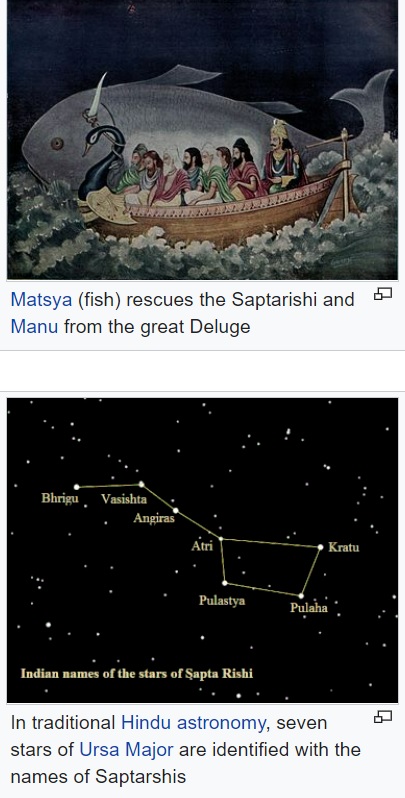The Saptarishi (from Sanskrit: सप्तर्षि (saptarṣī), a Sanskrit dvigu meaning "seven sages"; Sapta or Saptan - cognate with Latin Septem - seven, Rishi - sage(s)) are the seven rishis in ancient India, who are extolled at many places in the Vedas and other Hindu literature. The Vedic Samhitas never enumerate these rishis by name, though later Vedic texts such as the Brahmanas and Upanisads do so. They are regarded in the Vedas as the patriarchs of the Vedic religion.

World's Oldest Complete Torah Scroll Found by Italian Professor

Carl Linnaeus in his work Systema Naturae in 1758 assigned to the Indian peafowl the technical name of Pavo cristatus (means "crested peafowl" in classical Latin).
The earliest usage of the word in written English is from around 1300 and spelling variants include pecok, pekok, pecokk, peacocke, peocock, pyckock, poucock, pocok, pokok, pokokke, and poocok among others. The current spelling was established in the late 17th century. Chaucer (1343–1400) used the word to refer to a proud and ostentatious person in his simile "proud a pekok" in Troilus and Criseyde (Book I, line 210).
The Greek word for peacock was taos and was related to the Persian "tavus" (as in Takht-i-Tâvus for the famed Peacock Throne). The Ancient Hebrew word tuki (plural tukkiyim) has been said to have been derived from the Tamil tokei but sometimes traced to the Egyptian tekh. In modern Hebrew the word for peacock is "tavas". In Sanskrit, the peacock is known as Mayura and is associated with the killing of snakes.
The peacock was a symbol of immortality because the ancients believed that the peacock had flesh that did not decay after death. The Greek philosopher and mathematician Pythagoras wrote that the soul of Homer moved into a peacock, perhaps reflecting on the importance of the centuries-old popularity of the Greek poet.
The overall meaning of Peacock in Native American culture is self-confidence, self-esteem, dignity, refinement, knowledge, sexuality, pride, and beauty. According to some myths, in history, lore, and legend, the peacock symbol carries omens of nobility, guidance, holiness, watchfulness, and protection.
The peacock is the national bird of India. In Hinduism, the peacock serves as a mount for Skanda, the god of war. Numerous traditions, especially in southern India and Sri Lanka also relate it to local deities, representing for example the power of thunder.
Many of India’s folk dances show steps inspired by the peacock courtship dance. A popular belief of Hindu countries argues that when the peacock unfolds its tail it is a sign of rain. In ancient Greece, it was the symbolic bird of Hera, the most important Greek goddess of Olympus, legitimate wife of Zeus and goddess of women and marriage.
As they say, Hera commissioned Argos, a giant with a thousand eyes, to watch one of the lovers of her unfaithful husband but was killed by Hermes.
In Rome, princesses and empresses took the peacock as their personal symbol. In this way, the peacock passed to Christian symbolism strongly related to the Great Goddess so it is not difficult to understand his positive connection with the Virgin Mary and the delights of Paradise.
In the Christian religion
In the Christian religion, it is considered a resurrection symbol of Christ because in spring, Easter time, the bird changes completely of plumage. It is not usually represented with its tail deployed as it is an image that suggests vanity, a concept contrary to charity and the humility of the message of Christianity.
You can see mosaics of the fourth century with this figure in the church of Santa Constancia, in Rome, as well as in some Christian catacombs.
At the time of King Solomon, his fleet of Tarsis ships carried cargoes of “gold and silver, ivory, and monkeys and peacocks” on their three-year journeys. (1 Kings 10:22) Although some of Solomon’s ships traveled to Ofir (possibly, in the Red Sea area; 1 Kings 9:26-28), in 2 Chronicles 9:21 the transportation of the mentioned cargo is related – including the peacocks – with the ships that “went to Tarsis” (probably in Spain).
Therefore, it is not known for sure where peacocks were imported. It is argued that these beautiful birds are native to the SE. from Asia, and abound in India and Sri Lanka. There are those who believe that the Hebrew name (tuk · ki · yím) is related to the name tokei, “peacock” in ancient Tamil. Solomon’s fleet could have acquired the peacocks when they made their usual route and stopped at some commercial traffic center that had contacts with India.


No comments:
Post a Comment
Note: Only a member of this blog may post a comment.